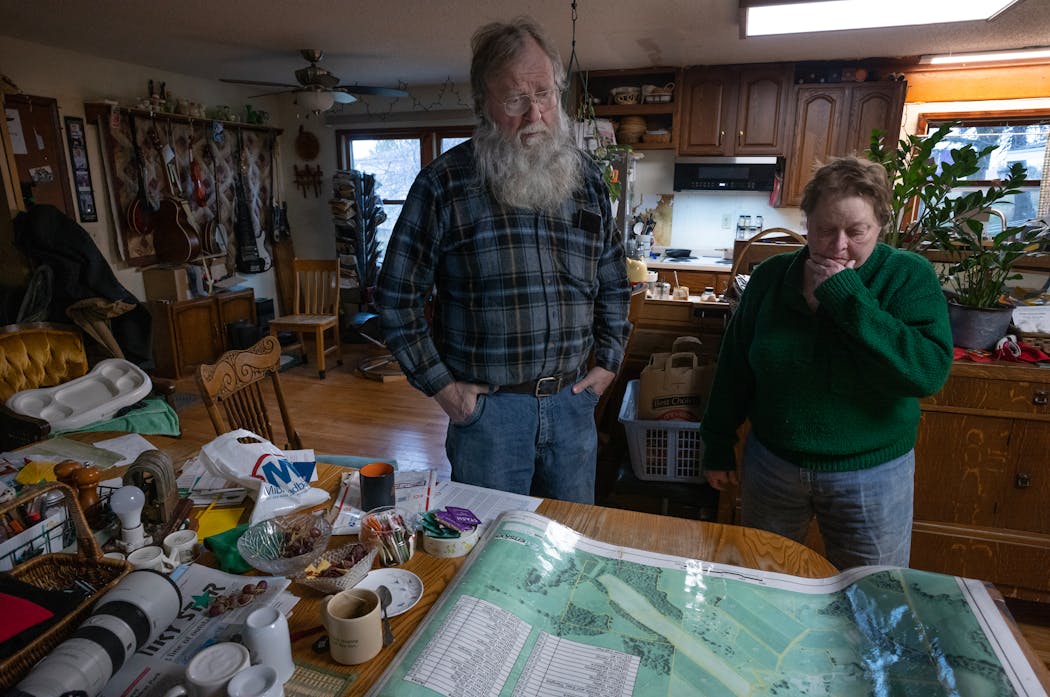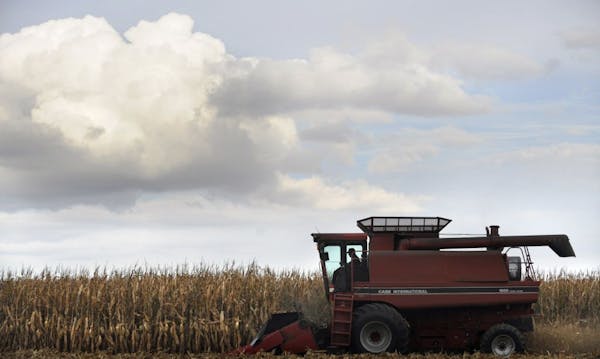CANTON, Minn. — Water shoots up from the hills of Vance and Bonnie Haugen's idyllic dairy farm here in a valley close to the Iowa border. That's why they named it Springside Farm in the '90s.
Unfortunately, the nitrate shoots up here, too.
Nitrate levels in the Haugens' water have steadily increased for the past 30 years, now ranging somewhere from 6 to 9 milligrams per liter of water every time they test their private well. The federal limit is 10 milligrams — any more and the pollution becomes dangerous for humans, especially infants.
Minnesota promised the federal Environmental Protection Agency (EPA) in December that it would act quickly to help residents in southeast Minnesota with dangerous levels of nitrate in their wells after the EPA urged the state to take action to protect people with polluted water.
State efforts are underway to inform farmers and landowners of the dangers in their water, and agencies have put together a timeline to address the issue. But four months after the promises, Minnesota has yet to deliver clean drinking water to people most in danger. Moreover, some residents worry about how seriously the state will treat nitrate pollution in the future.
"I want to have good, safe drinking water for myself and my children and grandchildren," Vance Haugen said. "And I want to farm, to be able to do both of those things. And I don't think they should be mutually exclusive."
Nearly 100,000 private well owners in the region are waiting for Minnesota to make good on its promises to the EPA. The state is finalizing a contract to provide drinking water over the next few months to residents who are pregnant or have infants. Officials say they were initially hampered by funding issues but have since allocated about $25,000 toward the water.
Starting in July, state agencies plan to provide free well testing and inventory all known private wells in the region. They'll also provide emergency fixes in areas where nitrate pollution is highest, meaning filtration systems and possibly new wells for landowners in some cases.
All of that depends on funding. Minnesota's Health and Agriculture departments, as well as the state Pollution Control Agency, need more than $7 million from the Legislature this session to realize those goals.
"We have never had a program like this before," said Tannie Eshenaur, director of the Department of Health's Water Policy Center.
The state's efforts aren't good enough for many of the residents who petitioned the EPA to address nitrate pollution last year. They argue that Minnesota has had decades to solve the issue but hasn't made meaningful progress. A coalition of Winona County residents and organizations sent a letter to state leaders in February urging them to act more quickly, saying the delay in providing drinking water until summer was unacceptable.
"We've heard 50 years of promises, all of them broken," said Jeff Broberg, a St. Charles resident and head of the Minnesota Well Owners Organization. "So we're taking a totally different stance on behalf of well owners now."
Complex flows
Minnesota has measured nitrate water pollution since 1990, though nitrate levels have largely risen across the state since then. While cities and towns have wastewater treatment plants to address pollutants in their water, private well owners aren't regulated. They have to treat water on their own.
Nitrate pollution stems from large-scale agriculture manure and fertilizer — about 90% of the nitrate in southeastern Minnesota's water comes from farming fertilizers spread on croplands, a state study found in 2013.
The problem is where the fertilizers end up. The land in southeastern Minnesota is particularly porous and filled with sinkholes that allow runoff from fields to end up in groundwater.
There are 10,000 sinkholes in Fillmore County alone, where more than 90 residents gathered March 27 to hear reports about nitrates from state officials.
Some residents at the meeting in the tiny city of Fountain's community center expressed concerns over nitrate levels in their water; others dismissed nitrates as part of farm life.
Ross Kramer of Fountain said he was paying attention to the issue but wasn't necessarily concerned about his property; nitrate levels there, he said, haven't been too high. But Kramer said does plan to have his well tested soon, once the state funding is available.
"I haven't done it in a while," he said. "Plus, it's free."
Many welcomed free well testing and more information from health, agriculture and environmental officials. But they were also cautious of the state's future work — a task force to address current nitrate measures and feedlot rules among other environmental concerns.
That could mean more regulations that could damage the small farms in the region, they said. The farmers drink the water here, too, they told officials, but they're operating on razor-thin profit margins, and further rules could hurt the local economy.
It could take decades to reverse the region's nitrate pollution, state officials said. They told farmers that they plan to create new nitrate strategies that can be replicated for other parts of Minnesota facing similar issues.
"The idea is just to make sure that we're hearing all perspectives, knowing that there's varying perspectives in this area," said Margaret Wagner of the Department of Agriculture.
'An effective change'
Minnesota officials want residents to participate in well testing, apply for water deliveries, if needed, and offer input on proposed changes such as bans on winter manure and fertilizer spreads.
"We have an incredible track record in Minnesota of protecting customers of public water supplies," Eshenaur said. "Now it's time to turn attention to the people that depend on private wells."
Some residents say the state is focusing on the wrong issues. Hydrologist Paul Wotzka said that Minnesota has taken too many "meaningless actions" that haven't stopped farm pollution from getting worse.
"If you've been at it for 35 years and you can't show positive results ... forgive my impatience and dismay, but they never saw this coming?" he said.
Wotzka owns about 10 acres in Weaver in Wabasha County, a mile or so from the Mississippi River. He and his wife grow crops on about a half-acre and keep a fruit orchard on another 7 acres. After eliminating the use of commercial fertilizer, Wotzka said, their water nitrate levels fell from 6 or 7 milligrams per liter when they bought the property in 1997 to about 1 milligram per liter today.
He said Minnesota is too quick to blame nitrate issues on old wells built before federal pollution regulations were enacted. Instead, Wotzka said, the state must focus more on addressing water sources.
"If we start cleaning up the aquifers through changing the land-use practices, the first water that's going to be impacted is the shallowest water and that's where the old wells are," he said. "We don't have an old well problem; we have a contaminated aquifer problem."
At their farm in Canton, Vance and Bonnie Haugen work about 270 acres with their son, Olaf. They haven't used commercial fertilizer in more than a decade, and they rarely use spot pesticides. They also encourage neighbors to use cover crops and other alternatives to help keep the nearby land in good health.
Still, they worry after reading newer research linking adverse health effects to drinking water with even lower levels of nitrate than the current 10 milligram standard: colorectal cancer, thyroid disease and neural tube defects.
The Haugens said they hope the state will move faster on addressing nitrates, even if it ruffles farmers like themselves. They say farmers care about the environment because it's their livelihoods.
"We're so interrelated and I think people are finally beginning to understand this," Bonnie said. "We've got to work on changing the narrative to get people to work together and make an effective change."

Want to share info with the Star Tribune? How to do it securely

'Safe recovery sites' would offer syringes, naloxone and more to people using drugs. The plan could be in peril.
New Minnesota GOP leaders seek peace with party's anti-establishment wing

Who is Republican Lisa Demuth, Minnesota's first House speaker of color?




